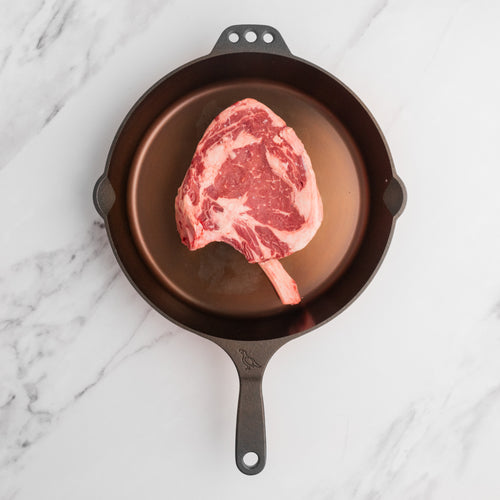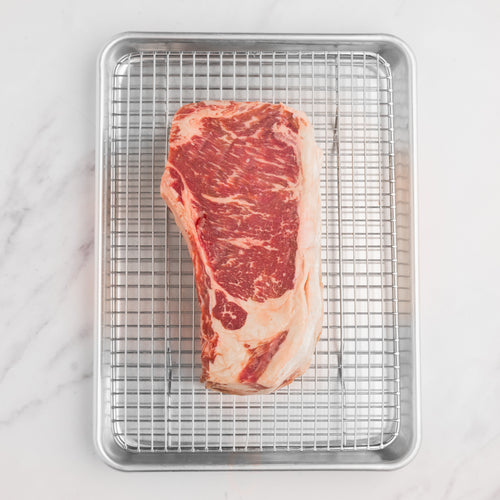
An Expert's Guide to Grills
There’s nothing like cooking in the great outdoors. The aroma and sound of steaks sizzling on an open grill are the best part of a summer day.
Whether you're looking for your first grill, looking to replace your current one or add a new piece of equipment to your collection, this guide will help you select the ideal grill for you and your cooking style.
Let's Get Grilling
The first step to successful outdoor cooking is selecting the grill that best suits your needs. Anyone who’s done a little grill shopping can tell you there are many choices available for cooking in the open air.
Which grill is best for you? Let’s start by looking at the different types of fuel used for outdoor grills. One note before we get started. Regardless of the grill purchased, its performance will be greatly improved by purchasing a high-quality thermometer. Handheld units are great for checking doneness of meat and models that monitor the grill temperature let you know what’s actually happening under the hood.
For a complete list of the tools and gear every grill master needs, check out our Grilling Essentials guide.
Fuel
There are three primary types of fuel used in grills and this is the primary way to categorize your outdoor cooking source.
Charcoal
This is the OG of grill fuel and produces very high heat that beautifully sears steak. Charcoal also imparts a smoky flavor that many associate with grilled meat.
This fuel is available in different forms. The most well know are the charcoal briquettes, those pillow-shaped black squares which are made from sawdust and small pieces of wood. Lump charcoal has enjoyed a strong following and is made by slowly burning pieces of wood in an oxygen free environment to extract sap, moisture and any natural chemicals. There are also rectangular shaped charcoal logs that have gained popularity.
Click here to buy from BBQGuys.
Gas
Gas is the most convenient form of fuel and falls into two types. The first is propane, the favorite fuel of Hank Hill and readily available. It’s usually purchased in portable 20 lb. metal tanks and is often available as an exchange program. The second type is natural gas which is piped into your home and requires a special connection to the outside grill.
Click here to buy from BBQGuys.
Wood Pellets
This fuel type looks exactly as you might imagine. Sawdust is compressed into pieces about the diameter of a pencil and are about ½” long. These are used in grills specifically designed for them. They burn clean and are available in different wood types to vary the smoke. This fuel produces low even heat ideal for larger cuts like pork shoulder and brisket. This is not the best fuel to generate high heat for searing steaks.
Click here to buy from BBQGuys.
Grill Types
Grills fall into the same category as fuel. Here is a look into each grill including pros/cons and the best application for each type.
Kettle Grills
This iconic grill shape is what many of us think of when it comes to outdoor cooking. These charcoal grills are available in a wide range of sizes (and colors) and can be purchased for a reasonable price. Weber is the industry leader providing a range of excellent quality grills. Many companies make these grills, but keep in mind that higher prices generally equate to better quality.
Although any type of charcoal can be used, these grills perform best with briquettes since they are uniform in size, burn at an even rate and can easily be set up at a consistent level or pushed to one side for 2-zone cooking.
- Size – Diameters of 14” to 22”. 22” is a good size providing 363 square inches of grill space.
- Price - $50 to $800
- Temperature Control – Very good, although this can vary with the features of each grill.
- Ease of Use – Very good. Use a charcoal chimney for fast and easy charcoal lighting.
- Sear – Excellent. These charcoal grills burn hot and put a nice char on steaks.
- Flavor – Excellent. The rendered fat dripping on coals produces wonderful savoriness.
Click here to buy from BBQGuys.
Kettle Grill Tips
- Use “natural” or “hardwood” briquettes since these do not contain any additional additives.
- Light charcoal with a chimney and avoid the off flavors of lighter fluid.
- Preheat your grill with the lid closed to prevent meat from sticking.
- Keep the lid closed to maintain heat and keep flare-ups to a minimum.
- Add chunks of hardwood, soaked in water, to add even enhance the charcoal flavor.
Gas Grills
Is convenience important to you? A gas grill might be the answer. Simply turn on the gas, ignite, preheat and you are ready for action. In addition, clean-up is less messy since there is no charcoal to wrangle or ash to dispose of after the cook. Adjusting the temperature of a gas grill is easy since all you must do is turn a knob.
It is important to obtain a gas grill with more than one burner, and three or more add even more flexibility and grilling capacity. Multiple burners let you set up the grill for two-zone cooking to cook more gently on the cool side, then provides plenty of BTUs for a final sear. Some higher-end grills include a sear burner, a special attachment that pumps out a high level of heat for an ideal final sear.
- Size – A huge range of options but choose one with at least two burners.
- Price - $150 to $5,000
- Temperature Control – Excellent, just turn the knob
- Ease of Use – Excellent, the easiest grill to own and operate.
- Sear – Very good. Unless your grill has a sear burner, gas grills don’t achieve the same heat as charcoal.
- Flavor – Very good. Added flavor can be developed by adding hardwood chips to the grill.
Click here to buy from BBQGuys.
Gas Grill Tips
- If using propane, keep an extra tank as a backup and avoid untimely shortages.
- Check gas lines for leaks and bad connections at least once a year.
- Leave one burner off to create a resting place in case of flare-ups.
- Keep the lid closed to maintain heat, especially for thick-cut steaks.
- Boost flavor by adding hardwood chips soaked in water on the coals or use a smoker box.
Wood Pellet Grill
A relative newcomer to the grilling world, wood pellet grills are outstanding for convenience and temperature control. They feature a large, continuous supply of fuel for “point and shoot” control that’s hard to beat when cooking larger cuts. Traeger is the most well-known brand of this genre and pioneered the technology in 1982. Today there are many competitors including big names like Weber and small production companies like Green Mountain, Memphis and MAK. Regardless of the maker, pellet grills have a lot of electronic bells and whistles like digital pellet controllers and wi-fi connections to monitor and control the cook. Keep in mind access to electricity is required to make these grills go.
Look for grills that can adjust the temperature in degrees. Some basic models have a simple “low, medium, high” dial which is less than optimal. Wood pellet grills are not cheap, and you pay for the convenience. As with most things, the more the features, the higher the price. Consider what you actually need before putting down your hard-earned cash.
Wood pellet grills truly excel for slow cooking meat and are the easiest way to smoke brisket or pork shoulder. They are not outstanding to use as regular grills. Despite recent improvements, less expensive charcoal grills do a much better job of producing a final sear. Regardless, these grills are worth a look.
- Size – Diameters of 14” to 22”. 22” is a standard size providing 363 square inches of grill space.
- Price - $350 to $5,000
- Temperature Control – Excellent, easy adjustment and “set and forget” for longer cooks.
- Ease of Use – Excellent. Digital controls make it simple to operate.
- Sear – Good. Perhaps the weakest point of wood pellet grills.
- Flavor – Excellent. Smoke levels can be increased by reducing the temperature.
Click here to buy from BBQGuys.
Wood Pellet Grill Tips
- Lower temperatures produce more smoke. Pellets burn clean at higher temps with almost no smoke.
- Clean the grill often. An ugly combo of grease and ash can build up inside and cause problems.
- Follow the maintenance plan – there are a lot of moving parts that require periodic attention.
- Play around with different wood pellets to find the right flavor profile for your cook.
- To get a nice final sear on steaks, preheat a cast iron skillet on the grill surface.
Kamado Style Grills
These ceramic clay grills trace their history back to the ancient Asian cookers. They became popular in the U.S. when military folks shipped them home after World War II. The Big Green Egg was introduced in 1974 and continues to be a top offering. There are numerous other brands to consider including Komodo, Kamado Joe, Primo and even Weber has grills in this category.
The thick sides of these grills retain and reflect heat well. The tight seal and vent system controls temperature very well. Because of the grill shape, they can be tricky to set up for 2-zone cooking. Optional ceramic inserts and divided fire bowls assist in controlling the temperature to one side. There are also oval shaped Kamado grills which alleviate this problem without extra equipment.
A big advantage of a Kamado grill is its versatility. They are outstanding smokers and roast meat exceptionally well. The thick sides also work in cold weather where thinner sided grills can struggle to maintain grilling temperatures. By closing all the vents, the coals are starved of oxygen and extinguished. Shake out the ash and the remaining charcoal is ready to go for the next grilling session.
Kamado grills use charcoal and take more work to light than a wood pellet or gas grill, however, with a little practice they can be quickly brought up to speed with minimal effort. These grills retain heat very well, so the cool down period takes longer than other grills. A purchase is more of an investment than a metal grill and can ring up in excess of $1,000.
- Size – A wide variety is available. For example, Big Green Eggs range from Mini (10”) to 2XL (29”)
- Price - $400 to $5,000
- Temperature Control – Excellent. The sealed lid and vent system is effective.
- Ease of Use – Very good.
- Sear – Excellent. These charcoal grills burn hot and put a nice char on steaks.
Click here to buy from BBQGuys.
Kamado Grill Tips
- Lump charcoal is our preferred fuel for Kamado-style cookers for high, even heat.
- Use a chemical free starter or torch to light the charcoal. No lighter fluid, please.
- Keep the lid closed to allow the ventilation system to do its job.
- Burp the lid before opening – open the lid an inch or two a couple times to prevent a face full of flame.
- Remove excess ash before using to keep the airflow moving through the Kamado
- We independently select all products and services. If you click through links we provide, we may earn a commission.
*We independently select all products and services. If you click through links we provide, we may earn a commission.







